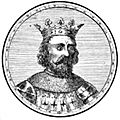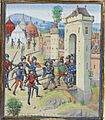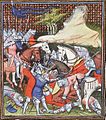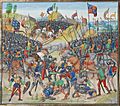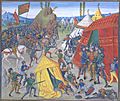Charles, Duke of Brittany facts for kids
Quick facts for kids Blessed Charles of Blois-Châtillon |
|
|---|---|
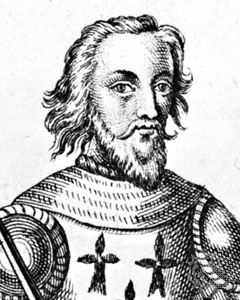 |
|
| Duke of Brittany | |
| Reign | 30 April 1341 – 29 September 1364 |
| Predecessor | John III |
| Successor | John IV |
| Born | c. 1319 Blois (France) |
| Died | 29 September 1364 (aged 44–45) Auray |
| Spouse | Joan, Duchess of Brittany |
| Issue | John I, Count of Penthièvre Marie, Duchess of Anjou Margaret, Countess of Angoulême |
| House | House of Blois-Châtillon |
| Father | Guy I, Count of Blois |
| Mother | Margaret of Valois |
| Charles de Châtillon | |
|---|---|
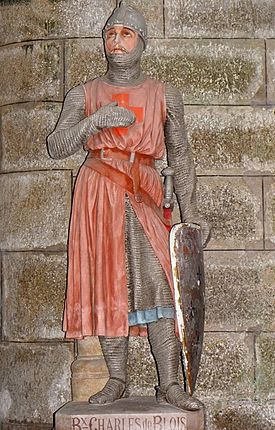
Statue of Blessed Knight Charles Châtillon de Blois in the Church of Notre-Dame de Bulat-Pestivien (Bretagne)
|
|
| Duke of Brittany, Patron of Europe | |
| Born | c. 1319 Blois, France |
| Died | 29 September 1364 (aged 44 – 45) Battle of Auray, Auray, France |
| Venerated in | Roman Catholic Church |
| Beatified | 14 December 1904 (confirmation of cultus) by Pope Pius X |
| Feast | 29 September (General Roman Calendar) |
| Attributes | sword, tabard with Brittany's coat of arms, armor, shield |
| Patronage | Army soldiers, agricultural workers |
Charles of Blois-Châtillon (born around 1319 – died September 29, 1364) was a very religious French nobleman. People often called him "the Saint." He became the Duke of Brittany in 1341 through his marriage to Joan, Duchess of Brittany. He ruled Brittany until his death, even though another nobleman, John of Montfort, also claimed the title.
Charles was known for his deep religious faith. After his death, there was a long effort to have him recognized as a saint. This process was supported by his cousin, Charles V of France, but opposed by his rival, John of Montfort. The effort slowed down for a while but was restarted much later. Charles of Blois was officially recognized as "Blessed" in 1904.
Contents
Life of Charles of Blois
Charles was born in Blois, a town in France. His father was Guy I, Count of Blois, and his mother was Margaret of Valois. Margaret was the sister of King Philip VI of France.
From a young age, Charles was very religious. He loved reading religious books, but his father thought it wasn't suitable for a knight. As he grew up, Charles showed extreme devotion. He would put small stones in his shoes to make walking uncomfortable. He also slept on straw instead of a soft bed. Every night, he would confess his sins. He even wore a rough, scratchy shirt called a cilice under his armor during battles. Despite these practices, he was a skilled military leader. His strong religious beliefs inspired loyalty in his soldiers.
His Marriage and Family
On June 4, 1337, Charles married Joan the Lame in Paris. Joan was the niece and heir of John III, Duke of Brittany. This marriage was very important because it gave Charles his claim to rule Brittany.
Together, Charles and Joan had five children:
- John I, Count of Penthièvre (1340–1404)
- Guy
- Henry (died 1400)
- Marie of Blois, Duchess of Anjou (1345–1404)
- Margaret of Blois, Countess of Angoulême
The Breton War of Succession
Charles and his wife, Joan, fought against the House of Montfort for control of Brittany. This long conflict was called the Breton War of Succession (1341–1364). The King of France supported Charles.
During this war, Charles made some very difficult decisions. For example, after the sieges of Quimper and Guerande, he ordered harsh actions against civilians. In 1347, after some early victories, Charles was captured by the English army. His captor was Thomas Dagworth.
Charles was held prisoner in England for nine years. While there, he often visited English graveyards to pray. He would recite Psalm 130. His squire, a young assistant, did not like this. The squire said that the people buried there had killed his family and burned their homes.
Charles was finally released in 1356 after a large ransom was paid. It was about half a million écus, a type of old French coin. When he returned to France, he decided to walk barefoot in winter from La Roche-Derrien to Tréguier Cathedral. He did this to show his devotion to Saint Ivo of Kermartin. People heard about his plan and put straw and blankets on the road to protect his feet. But Charles chose a different path to avoid them. His feet became so sore that he couldn't walk for 15 weeks. After he recovered, he continued the war against the Montforts.
Charles was killed in battle during the Battle of Auray in 1364. This battle was a major turning point. The war ended with the Montforts winning, as decided by the second Treaty of Guerande in 1381.
Becoming a Blessed Saint
Charles was buried in Guingamp. The Franciscans, a religious group, began to promote him as a saint and martyr, even though it wasn't officially approved yet. Many people visited his tomb and left gifts, called ex votos. In 1368, Duke John IV of Brittany asked Pope Urban V to stop this unofficial worship. The Pope agreed, but the local bishops couldn't stop the people.
However, Charles's family worked hard to have him officially recognized as a saint by the Roman Catholic Church. With pressure from Charles V of France, Pope Urban agreed to start an investigation. Pope Urban died in 1370. The investigation continued under the next Pope, Pope Gregory XI. A report was sent to Avignon, where the Pope was living at the time. Three cardinals were appointed to review the case.
The Pope later moved back to Rome in 1376 and died in 1378. The documents for Charles's case likely went to Rome. For a long time, nothing more happened with his cause for sainthood. In 1454, Charles's grandson encouraged his relatives to keep trying.
The process was finally reopened in 1894. On December 14, 1904, Charles de Châtillon was officially declared "Blessed Charles of Blois" by Pope Pius X. His feast day is celebrated on September 30.
Images for kids
-
The Saint Charles de Châtillon de Blois, battles gallery, Versailles castle, France
-
The Saint Charles de Châtillon in the glass window of the Church Saint-Pierre in Plounéour-Trez, France
-
The Saint Charles de Châtillon in the glass window of the Church Saint-Malo in Dinan, France
-
Battle of Auray in the glass window of the Church of Notre-Dame-de-Bonne-Nouvelle, Rennes
See also
- John of Montfort
- Counts of Blois
- Luis de la Cerda, also known as Louis of Spain, a commander of Charles during the Breton War of Succession
- Dukes of Brittany family tree
- House of Châtillon
- Olivier IV de Clisson


